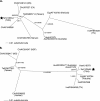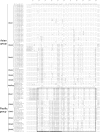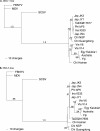Reassortment and concerted evolution in banana bunchy top virus genomes
- PMID: 17135318
- PMCID: PMC1797577
- DOI: 10.1128/JVI.01390-06
Reassortment and concerted evolution in banana bunchy top virus genomes
Erratum in
- J Virol. 2008 Jun;82(12):6088
Abstract
The nanovirus Banana bunchy top virus (BBTV) has six standard components in its genome and occasionally contains components encoding additional Rep (replication initiation protein) genes. Phylogenetic network analysis of coding sequences of DNA 1 and 3 confirmed the two major groups of BBTV, a Pacific and an Asian group, but show evidence of web-like phylogenies for some genes. Phylogenetic analysis of 102 major common regions (CR-Ms) from all six components showed a possible concerted evolution within the Pacific group, which is likely due to recombination in this region. The CR-M of additional Rep genes is close to that of DNA 1 and 2. Comparison of tree topologies constructed with DNA 1 and DNA 3 coding sequences of 14 BBTV isolates showed distinct phylogenetic histories based on Kishino-Hasegawa and Shimodaira-Hasegawa tests. The results of principal component analysis of amino acid and codon usages indicate that DNA 1 and 3 have a codon bias different from that of all other genes of nanoviruses, including all currently known additional Rep genes of BBTV, which suggests a possible ancient genome reassortment event between distinctive nanoviruses.
Figures







Similar articles
-
Identification and characterization of a distinct banana bunchy top virus isolate of Pacific-Indian Oceans group from North-East India.Virus Res. 2014 Apr;183:41-9. doi: 10.1016/j.virusres.2014.01.017. Epub 2014 Jan 24. Virus Res. 2014. PMID: 24468493
-
Additional rep-encoding DNAs associated with banana bunchy top virus.Arch Virol. 2001;146(1):71-86. doi: 10.1007/s007050170192. Arch Virol. 2001. PMID: 11266219
-
Characterisation of Rep-encoding components associated with banana bunchy top nanovirus in Vietnam.Arch Virol. 2002 Apr;147(4):695-707. doi: 10.1007/s007050200019. Arch Virol. 2002. PMID: 12038681
-
Unusual events involved in Banana bunchy top virus strain evolution.Phytopathology. 2009 Jul;99(7):812-22. doi: 10.1094/PHYTO-99-7-0812. Phytopathology. 2009. PMID: 19522579
-
Evolution and taxonomy of positive-strand RNA viruses: implications of comparative analysis of amino acid sequences.Crit Rev Biochem Mol Biol. 1993;28(5):375-430. doi: 10.3109/10409239309078440. Crit Rev Biochem Mol Biol. 1993. PMID: 8269709 Review.
Cited by
-
Evolutionary dynamics of genome segmentation in multipartite viruses.Proc Biol Sci. 2012 Sep 22;279(1743):3812-9. doi: 10.1098/rspb.2012.1086. Epub 2012 Jul 4. Proc Biol Sci. 2012. PMID: 22764164 Free PMC article.
-
Recombination in eukaryotic single stranded DNA viruses.Viruses. 2011 Sep;3(9):1699-738. doi: 10.3390/v3091699. Epub 2011 Sep 13. Viruses. 2011. PMID: 21994803 Free PMC article. Review.
-
The global distribution of Banana bunchy top virus reveals little evidence for frequent recent, human-mediated long distance dispersal events.Virus Evol. 2015 Sep 10;1(1):vev009. doi: 10.1093/ve/vev009. eCollection 2015. Virus Evol. 2015. PMID: 27774281 Free PMC article.
-
Two distinct nanovirus species infecting faba bean in Morocco.Arch Virol. 2010;155(1):37-46. doi: 10.1007/s00705-009-0548-9. Epub 2009 Nov 22. Arch Virol. 2010. PMID: 20069400 Free PMC article.
-
Identifying geographic hot spots of reassortment in a multipartite plant virus.Evol Appl. 2014 May;7(5):569-79. doi: 10.1111/eva.12156. Epub 2014 Apr 9. Evol Appl. 2014. PMID: 24944570 Free PMC article.
References
-
- Allen, R. N. 1987. Further studies on epidemiological factors influencing control of banana bunchy top disease, and evaluation of control measures by computer simulation. Aus. J. Agric. Res. 38:373-382.
-
- Avise, J. C. 2000. Phylogeography. Harvard University Press, Cambridge, MA.
-
- Beetham, P. R., R. M. Harding, and J. L. Dale. 1999. Banana bunchy top virus DNA-2 to 6 are monocistronic. Arch. Virol. 144:89-105. - PubMed
-
- Bell, K. E., J. L. Dale, C. V. Ha, M. T. Vu, and P. A. Revill. 2002. Characterisation of Rep-encoding components associated with banana bunchy top nanovirus in Vietnam. Arch. Virol. 147:695-707. - PubMed
-
- Bryant, D., and V. Moulton. 2004. Neighbor-Net: an agglomerative method for the construction of phylogenetic networks. Mol. Biol. Evol. 21:255-265. - PubMed
Publication types
MeSH terms
Substances
Associated data
- Actions
- Actions
- Actions
- Actions
- Actions
- Actions
- Actions
- Actions
- Actions
- Actions
- Actions
- Actions
- Actions
LinkOut - more resources
Full Text Sources

